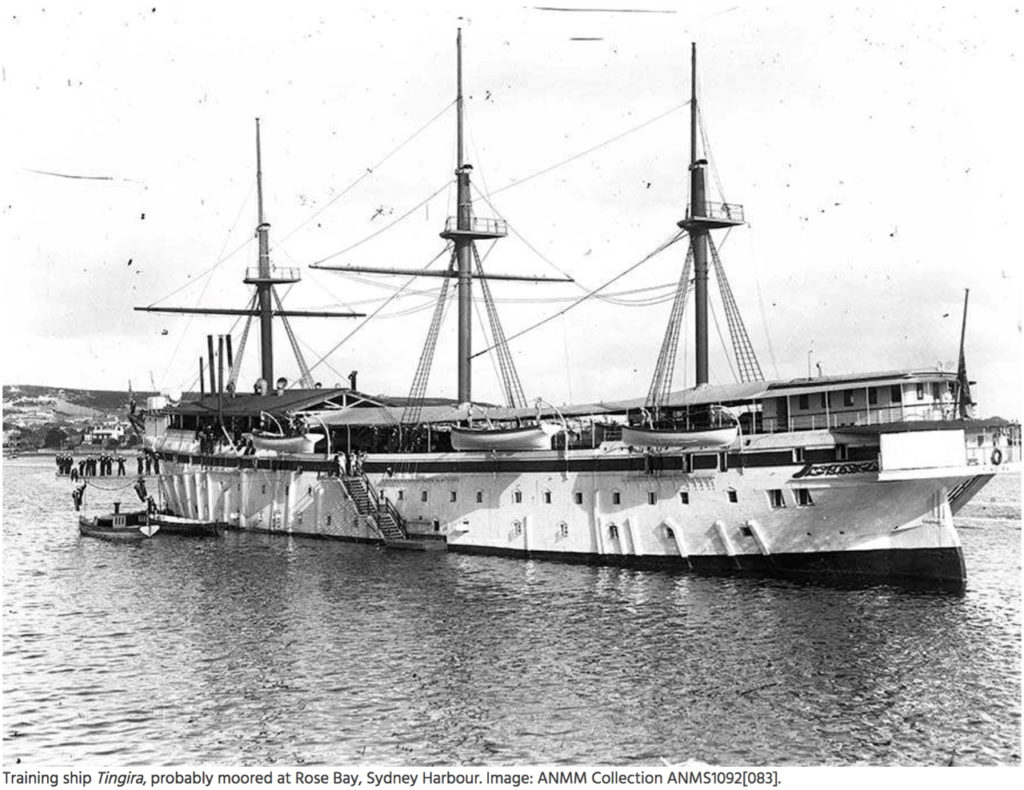The Soldier's Details

- Surname:
- Willimott
- First Name:
- George Edwin
- Rank:
- Private
- Regimental #:
- WX11744
- Classification:
- Fitter
- Company:
- Attached 2/4th, 88 Light Aid Detachment
- Enlisted:
- 21.04.1941
- DOB:
- 2.11.1910
- Place of Birth:
- Oakleigh, Victoria
- Father's Name:
- Walter James Willimott
- Mothers's Name:
- Annie Willimott (nee Leith)
- Religion:
- Church of England
- Pre-war Occupation:
- Truck Driver
- Memorial:
- Thanbyuzayat War Cemetery, Plot A13, Row D, Grave 7, Age 32.
- Singapore:
- Selarang Camp Changi
- Force:
- 'A' Force Burma, Green Force, No .3 Battalion
- Camps Burma:
- Victoria Point, Kendau 4.8km, Thetkaw 14km, Meiloe, Augganaung - probably evacuated to Thanbyuzyat Hospital.
- POW#:
- 3071
- Cause of Death:
- Dysentery
- Place of Death:
- Thanbyuzayat
- Date of Death:
- 4.06.1943
- Buried:
- Grave No. A46, Thanbyuzayat
General Description
George Willimott reported sick to Regimental Aid Post at Kendau 4.8km Camp on 17.11.1942 and may then have been evacuated to hospital camp at Thanbyuzayat.
His older brother is James (Jim) Frederick Willimott, WX11745 who died about 6 months later at Kanchanaburi.
George aged 30 years & James Willimott enlisted on same day 21 April 1941, firstly as reinforcements then joining 88th Light Aid Detachment where George entered training to be Driver’s Mechanic. He was sent to SA and NT with 2/4th before sailing to Singapore.


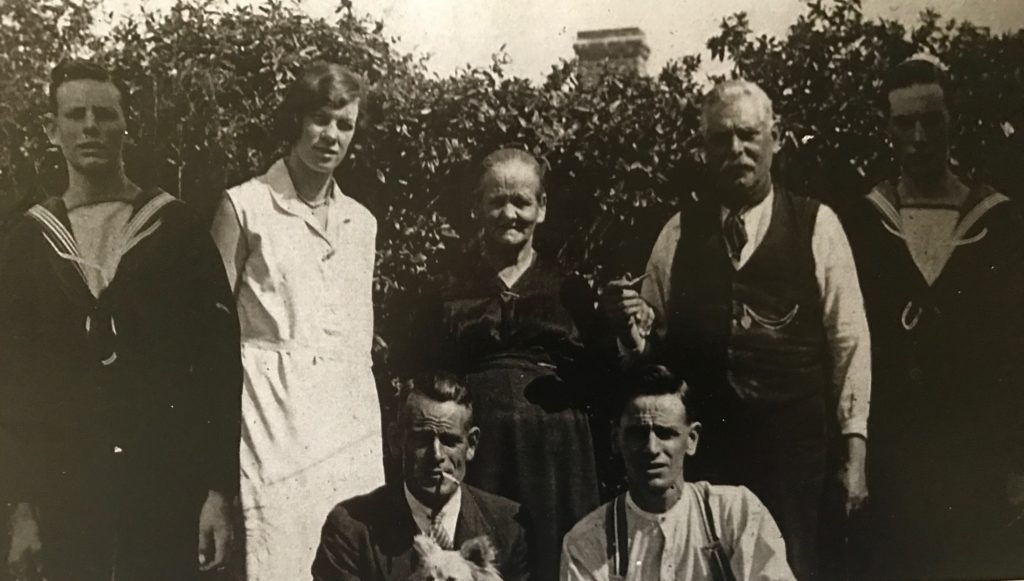
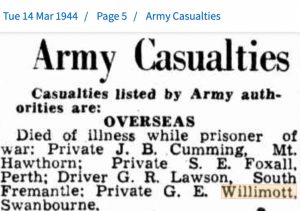




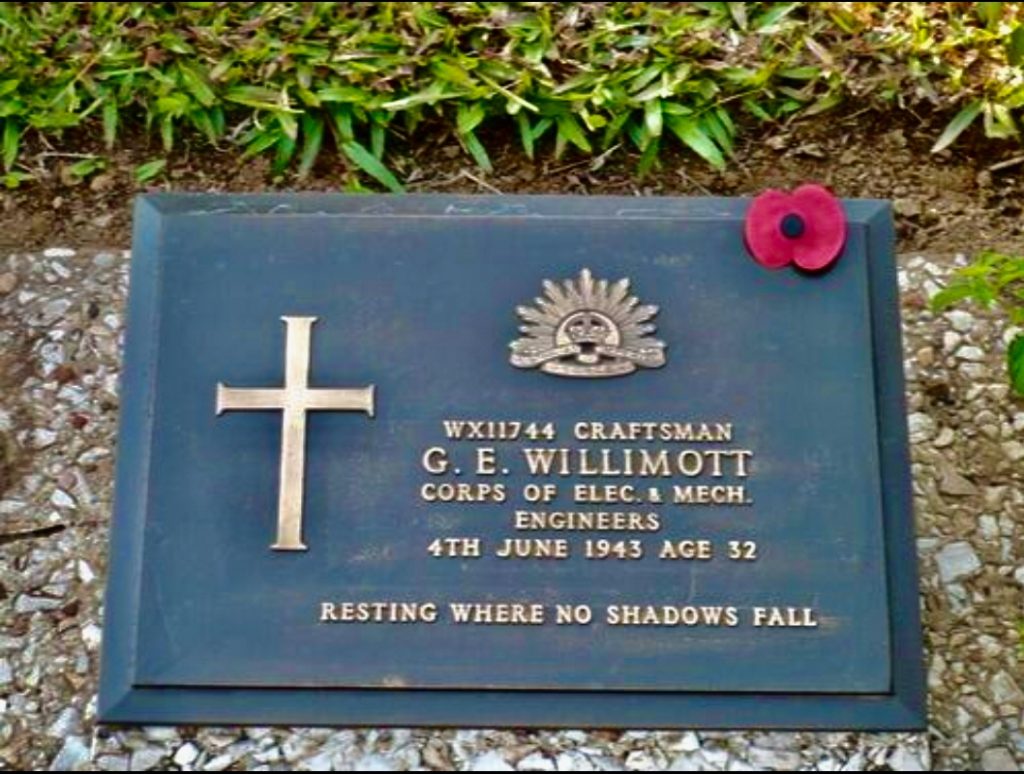
Above: George Willimott’s grave at Thanbyuzyat War Cemetery Myamar.
There were 4 boys in the Willimott family – first two John and James born in England, Albert born in New Zealand and George born in Victoria.
It is not known when the Willimott family moved to WA; parents Walter Willimott and Annie Leith were residing in Swanbourne about the time George and James died.
Below: Walter Willimott died in 1933.
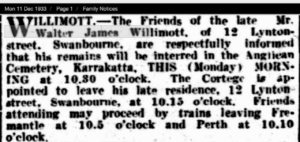
Below: Jim’s death is reported in 1945.


Below: Annie Willimott died in 1952.
She had to endure alone, the grief of George and Jim not returning home after the war.
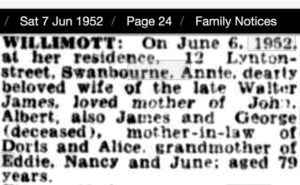
As a POW in Singapore George was selected to work on Burma end of Burma-Thai Railway. He was one of 3,000 POWs who sailed from Singapore with ‘A Force Burma Green Force No. 3 Battalion to south west coast of Burma. George was with Green Force with included a very large number of 2/4th boys and they stopped off at Victoria Point to repair and enlarge the aerodrome.
By 1st Oct 1942 they started work on the railway – Burma end at Kendau 4.8 km. This work force would remain working on the rail link until the end of 1943.
Please read further about ‘A’ Force Burma Green Force No. 3 Battalion
Below: death notices fo George – in March 1944. Confirmation of George’s death would have come from survivors of ‘Rakuyo’ Maru. They were returned home having survived the sinking 12 Sept 1944 South China Sea and being picked up by several US Naval submarines.

Below: background information on ‘Tingira’ Cadet Training Ship.


George signed up as a naval cadet in Sydney. As you can see young boys absconding seems a regular occurrence – the Navy reported the opposite, saying there were very few desertions. There were several newspaper reports there had been caning of cadets on Tingira around 1919.
Not sure when George joined the Naval Cadets – He was soon after charged with deserting. To date we have not been able to find any documentation or reports on what punishment was served on these young boys.
‘The boys will undergo a discipline that should inculcate in them valuable habits of promptitude and exactness, factors making for the building up of character. Then, as a result of their Naval training, many boys will doubtless form loftier notions of all that is conveyed in the words ‘Duty’, ‘Honour’, and ‘Conduct’, so obliging themselves for the praiseworthy discharge of their obligations of citizenship, when they arrive at man’s estate.’
Life for cadets on the Tingara was not easy. It was a 0530 start until ‘turn in’ at 21.30. Skills taught included rowing, sailing, signalling, rope & wire work, anchor work, mechanics and firearms as well as general schooling.Swimming was compulsory and boys participated in some sports daily.
Leave was limited to 5 hours ashore 1200 to 1860 every Wednesday
Local boys, i.e. Sydney boys were permitted to go home each weekend from midday Saturday until early Sunday evening.
Indiscretions resulted in corporal punishment.
‘After a vigorous half an hour of physical training all of the boys would be ordered over the ships rigging three times before mustering for breakfast. Grace was said before all meals which were overseen by the ship’s padre. On completion of breakfast the day’s classroom and practical instruction began, continuing until 1600 at which time the boys turned their attention to domestic duties or compulsory organised sport.
At 1900, on completion of supper, the boys were allowed to write letters or participate in voluntary games until 2030 when they were fallen in before being ordered to ‘turn in’. Lights out occurred promptly at 2100.
During her 15 years in commission 3158 boys were trained on ‘Tingira’ and most took their place as sailors in the fleet. Many served in the RAN during the two World Wars and some, such as Signalman JW Varcoe, DSM and Petty Officer JT Humphries, GM were decorated for individual acts of gallantry during those conflicts.
The last draft of the ‘Tingira’ boys began their training in 1926 and in August that year recruiting of boys ceased. On 30 June 1927 ‘Tingira’ paid off and after passing through the hands of a number of different owners she was broken up in Sydney in 1941‘.
The above information from… . http://www.navy.gov.au/node
Below: George’s naval record. He was 12 years old when he enlisted.


Below: letter written 1925 by George’s father.

Camp Locations:
- Selarang Camp Changi - Singapore
- Aungganaung,105Kilo - Burma
- Kendau, Kandaw, 4 Kilo - Burma
- Meilo, 75 Kilo, 340k - Burma
- Thanbyuzayat, 415k - Burma
- Victoria Point, Kawthoung - Burma. \'A\' Force, Green Force No. 3 Btn
- Thetkaw 14 Kilo - Burma

